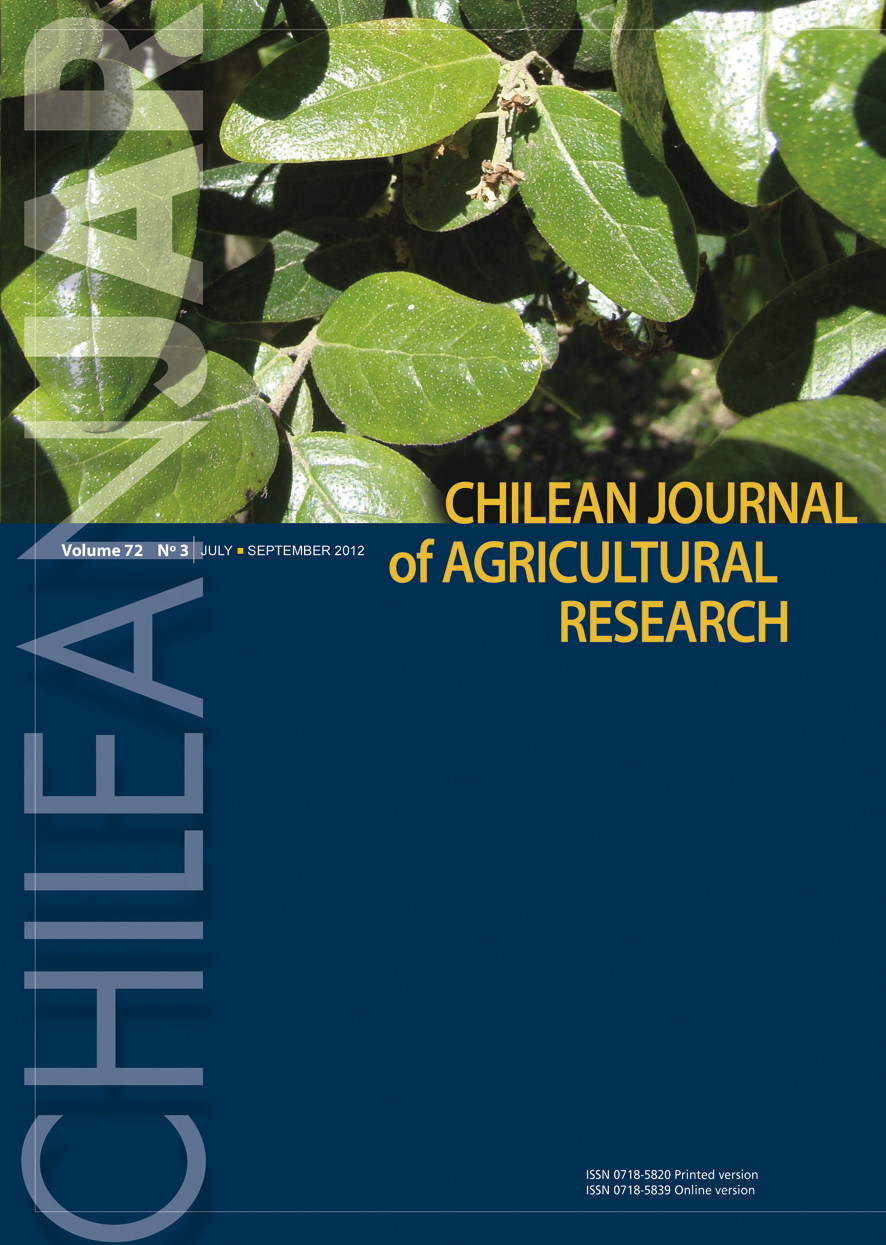
|
Chilean Journal of Agricultural Research
Instituto de Investigaciones Agropecuarias, INIA
ISSN: 0718-5820
EISSN: 0718-5820
Vol. 70, No. 1, 2010, pp. 95-103
|
 Bioline Code: cj10010
Bioline Code: cj10010
Full paper language: English
Document type: Research Article
Document available free of charge
|
|
|
Chilean Journal of Agricultural Research, Vol. 70, No. 1, 2010, pp. 95-103
| en |
Inventory of ammonia emissions from livestock production in Los Lagos and Los Ríos regions, Chile
Martínez-Lagos, Josué; Salazar, Francisco; Alfaro, Marta & Misselbrook, Tom H.
Abstract
This paper presents the first inventory of ammonia emissions from livestock production in Los Lagos and Los Ríos Regions of Chile. The inventory was focused in this area because is where cattle production is concentrated. This study aimed to quantify the amount of N losses due to ammonia volatilization from livestock production in these regions of the country, and to provide its spatial representation identifying their main sources. Calculations have been carried out for 1997 and 2007, and also projections to 2017 and 2027 were obtained. Calculated emissions were 6097 and 6206 t NH3-N for 1997 and 2007, respectively. Major sources of NH3-N emissions were cattle accounting for more than 85%, followed by horses and pigs. Farm management practices as grazing, housing, manure storage and land spreading of manure accounted for 87%, 9%, 3%, and 2%, respectively, of total annual emissions. Projections suggest that emissions could increase up to 6344 and 6516 t NH3-N for 2017 and 2027, respectively. Emissions are much lower than those reported for developed European countries. However, intensification of cattle production systems may lead to an increase of ammonia emissions which could impact the temperate forest of Southern Chile characterized by low nutrient fluxes.
Keywords
ammonia, inventory, livestock production, emissions
|
| |
| es |
Inventario de emisiones de amoníaco de la producción pecuaria de las Regiones de Los Lagos y de Los Ríos, Chile
Martínez-Lagos, Josué; Salazar, Francisco; Alfaro, Marta & Misselbrook, Tom H.
Resumen
Este artículo presenta el primer inventario de emisiones de amoníaco de la producción pecuaria de las Regiones de Los Lagos y Los Ríos de Chile, porque esta área concentra la producción chilena de ganado bovino. Este estudio tuvo como objetivos cuantificar las pérdidas de N por volatilización de amoníaco emitidas desde la producción animal en estas regiones del país, y proveer su representación espacial identificando las principales fuentes de emisión. Los cálculos fueron realizados para 1997 y 2007; y desde el año base se proyectaron emisiones para los años 2017 y 2027. Las emisiones calculadas fueron 6097 y 6206 t NH3-N para 1997 y 2007, respectivamente. Las principales fuentes de emisión fueron los bovinos con más del 85% de las emisiones, seguido por equinos y porcinos. Prácticas de manejo de las explotaciones pecuarias como el pastoreo, la estabulación de ganado, el almacenamiento y la aplicación de desechos aportaron el 87%, 9%, 3% y 2%, respectivamente, del total de las emisiones anuales. Las proyecciones sugieren que las emisiones pueden alcanzar las 6344 y 6516 t NH3-N para el 2017 y 2027, respectivamente. Estas emisiones son mucho menores que las reportadas por algunos países europeos desarrollados. Sin embargo, la intensificación de los sistemas productivos ganaderos puede conllevar al aumento en las emisiones de amoníaco, las cuales pueden provocar un impacto en los bosques templados del sur de Chile caracterizados por bajos flujos de nutrientes.
Palabras-clave
amoníaco, inventario, producción animal, emisión
|
| |
© Copyright © 2010 - Universidade de Santa Cruz do Sul
Alternative site location: http://www.inia.cl
|
|
